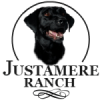Posts Categorised: Dog show
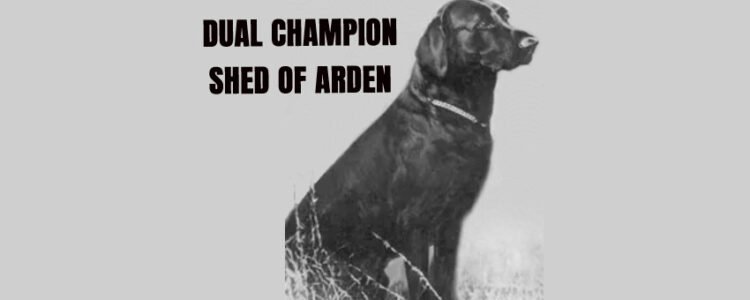
“Shed of Arden’s qualities were of the highest: he epitomized an ideal. …By those who are knowledgeable, he was considered to have embodied the greatest qualities a Retriever can possess in equal parts: looks, performance, and the priceless gift to transmit these from generation to generation.”
~ Helen Warwick, Lockerbie Labradors
SHED OF ARDEN’S STORY
3xNFC CFC DUAL CH Shed of Arden is one of the best-known Labrador Retrievers in history, but what do we know about him and his family?
Shed was born March 26, 1939, and bred by William Averell Harriman who owned Arden kennels. Paul Bakewell III of Deer Creek Kennels bought Shed as a young dog.
There’s a story that his siblings were all named for fish and that he was supposed to be Shad of Arden. Due to a clerical error he became Shed instead.
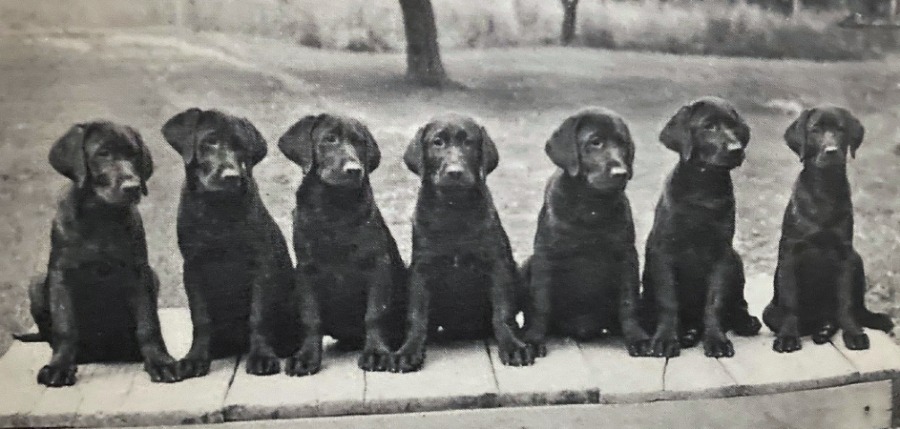
The Arden ‘fish’ litter, including Shed, Bass, Marlin, Trout.
Show competition
Although Shed often competed in the show ring and field at the same time, he started his career in the show ring. At 14 months old he won Winners Dog and Best of Winners for a 5-point major at the Labrador Retriever Club’s specialty show in 1940. His older brother, CH Earlsmoor Moor of Arden, won Best in Specialty at that show. A week later the brothers repeated their wins at another show with another major for Shed.
He finished his show championship 15 months later with two Best of Breed wins and a Group 4th.
Field Competition
Retriever field trials in America were still in their infancy when Shed was born. It was only nine years since his uncle, NFC Blind of Arden, won the first field trial.
Shed started his field career with a Derby second at 20 months, still owned by his breeder.
The next year he started earning points in field competition. By the fall of 1942, he had finished his field championship to become a dual champion. He also qualified for the National Retriever Championship.
First National Championship
As a 3-year-old, Shed won his first National Championship. He was handled by Lt. Bakewell who was on leave from the Navy Air Corps.
Madison, Wisconsin hosted the National on December 4-6, 1942. The weather was cold. “The Yahara River and adjoining marshes which ordinarily afforded everything desired for water tests were frozen solid…. This necessitated moving the water tests to the University of Wisconsin property along the shores of Lake Mendota. Heavy ice floes made it dangerous for dogs to get into the water. Several refused to enter, others only after repeated commands.” 1
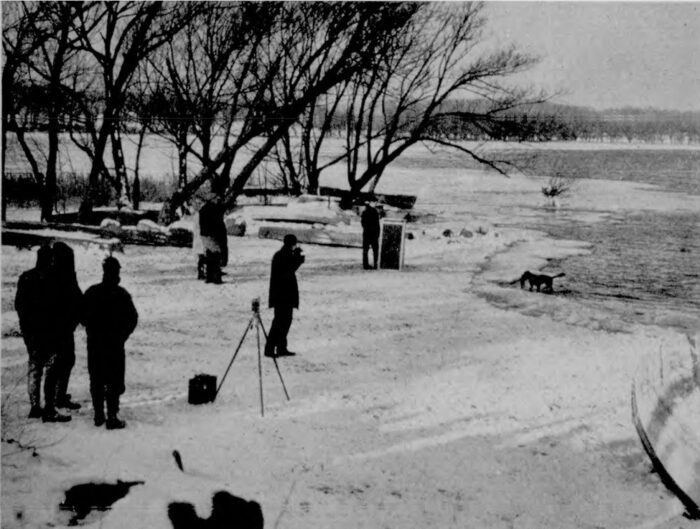
Icy conditions on Lake Mendota. Photo courtesy American Kennel Gazette.
“The weather was bitter and difficult on the great gallery, but it was weather to be expected in the final week of the Wisconsin duck hunting season and no dog who could not meet these conditions could rightfully aspire to the national title.” 2
“To win, Shed had to show supreme ability to bound over frozen hummocks in quest of pheasants and to break sheets of ice in swimming after ducks. In fact, it is hard to imagine more trying conditions than those which the dogs, their handlers and the gallery faced during the three days of the stake. The thermometer was never far from zero, and frequently was below that mark….” 3
Eighteen dogs started, but only five finished, including two owned by Bakewell – Shed and FC Stilrovin Super Speed. The other finishers were FC Hiwood Mike, Patricia of Roedare, and Seaborne’s Black Prince.
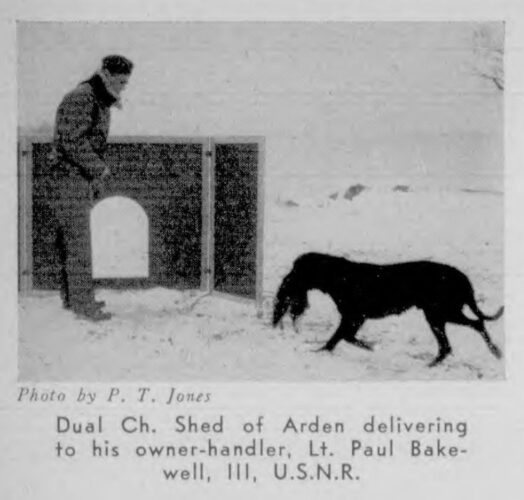
Shed of Arden delivering a bird. Photo courtesy American Kennel Gazette.
“Throughout the meeting Shed did everything asked of him, and did it brilliantly. Probably the thing that most pleased the gallery was the way that willingness was demonstrated when, in the final water test, he never hesitated a minute in crashing his way out through brittle ice…” 4
Second National Championship
Shed won the National Championship again the next year. He was handled by Clifford H. Wallace because Lt. Bakewell was on active duty.
Bourbon, Missouri hosted the stake on December 3-5, 1943. Twenty dogs started, of those 15 were Labs and five were Goldens. It took two extra series to determine the winner between two dogs – Shed and a Golden Retriever named FC Stilrovin Super Speed. Both dogs were owned by Lt. Bakewell.
Cotton Pershall trained Shed until until it was time to join the Army. At that point, Clifford Wallace took over and guided Shed through the grueling tests in Missouri.
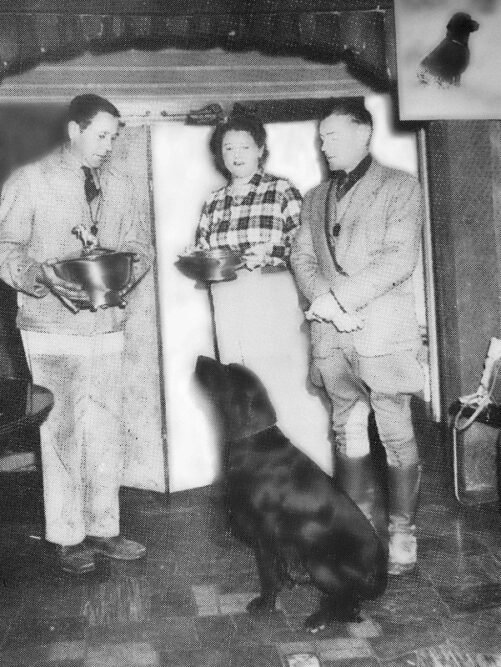
Mrs. Bakewell with Shed and handler C.H. Wallace. Presenting the trophy was M.B. Wallace Jr, trail chairman. Photo courtesy American Kennel Gazette.
Shed didn’t compete in the 1944 National. However, he did travel to Vancouver, British Columbia in October where he finished his Canadian Field Championship.
Third National Championship
World War II ended in 1945 after Germany surrendered in May and Japan surrendered in September. That November Shed and Bakewell were back to compete in the National Championship. This time it was held at Shelter Island, Long Island, New York, which meant a daily ferry ride from Riverhead. The stake was held on November 30-December 2, 1945.
The first day brought blinding snow and sleet which limited the day to only one series. The second day was cold and windy with high tides and northerly winds. The judges ran land tests in the morning and water tests as the tide ebbed. Despite the conditions, only six dogs were dropped.
Although Shed was a finalist, the judges awarded the win to Black Magic of Audlon.
Fourth National Championship
Although Shed was now seven-years-old, he continued competing at trials around the country. At a trial in Oregon he had a 300-yard blind retrieve across the tip of a lake for a shackled duck planted several yards off the shore. He was one of only six dogs to complete the series.
In the fall of 1946, Shed reclaimed his crown and is the only three-time winner of the National Championship. It was held on December 6-8. The grounds were good at Crab Orchard Lake, Herrin, Illinois, as was the weather. This is a coal mining area, and the mines were on strike at the time of the National. “… the gallery was augmented by many hundred miners who came to see the event. Some estimated the gallery at 10,000. Traffic presented a bit of a problem.” 5
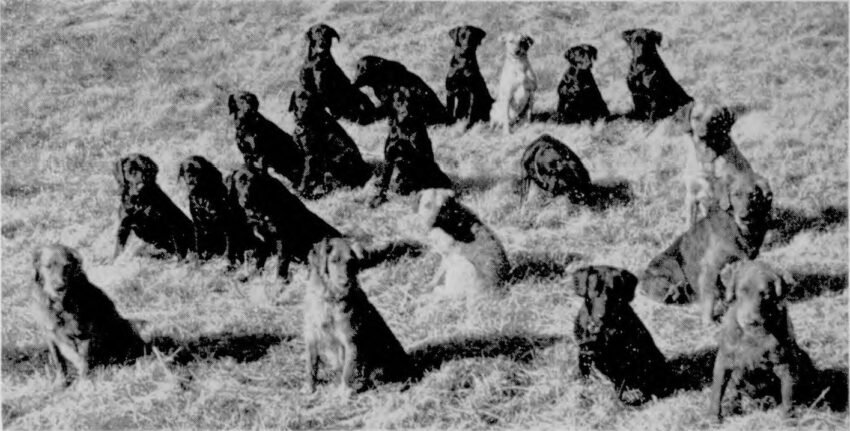
The 20 dogs entered in the 1946 National Championship Stake. Photo courtesy American Kennel Gazette.
Twenty dogs started the stake and eight finished.
In the final series, Shed faced off against three tough competitors. They were his kennel mate, Dual Champion Little Pierre of Deer Creek, plus FC Scoronine of Deer Creek, and a Golden retriever named Stilrovin Nitro Express.
“Scoronine led the field until the last day, then refused to plunge into the 45° water. Now it was Shed’s turn.
“In the toughest test, he had to find two dead ducks which had been planted among the rushes across a 150-foot-wide bay. Shed waited calmly at the water’s edge until he got the signal from Bakewell. Then he plunged bravely into chilly Crab Orchard Lake, but not with his old zip.
“… One-third of the way across, Shed’s black head turned at a whistle from Bakewell to get directions. He entered the cattails just six feet from where the mallard was hidden, sniffed for a second, found his bird. A few minutes later, Shed did it again, and won his third U.S. championship.” 6
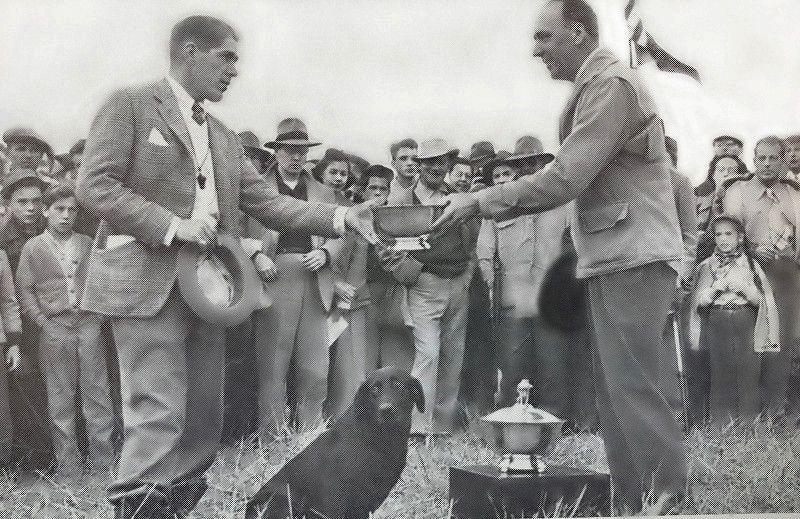
Paul Bakewell received the championship trophy for Shed’s third national championship.
Fifth National Championship
Shed ran the National Championship one more time. The 1947 National was again held at Crab Orchard Lake, Herrin, Illinois. The weather was good with only occasional light rain. Twenty one dogs started, but only four dogs finished. These dogs completed the tenth – and the eleventh – and the twelfth series in an effort to determine the winner. The final series was completed in near darkness.
These dogs were:
FC Black Panther, owned by CW Carlson
FC Black Roland of Koshkonong, owned by Wesley Jung
FC Bracken’s Sweep, owned by DE Pomeroy
DUAL CH & 1942 , 1943, 1946 NATL CH Shed of Arden, owned by Paul Bakewell
Bracken’s Sweep, handled by TW “Cotton” Pershall, was crowned the winner.
SHED’S FAMILY
| CH Raffles of Earlsmoor | Thatch of Whitmore CCW | Eng DUAL CH Titus of Whitmore |
| Tee of Whitmore | ||
| Task of Whitmore CCW | Toi of Whitmore FTW | |
| Eng CH Teazle of Whitmore | ||
| FC Decoy of Arden | Odds On FTW | The Favorite FTW |
| Jest | ||
| Peggy of Shipton FTW | Ronald of Candahar | |
| Gehta of Sigeforda |
His parents
Shed’s sire, Raffles, was Dr. Samuel Milbank’s first Labrador although dogs were always part of his life. His father, Dr. Milbank, Sr., bred Chesapeake Bay Retrievers and terriers. A Scottish surgeon started the junior Dr. Milbank into Labradors when he found and shipped Raffles to him. According to Helen Warwick in The Complete Labrador Retriever, importing Raffles “started a collaboration of Dr. Milbank and W.A. Harriman that molded the fortunes of the Arden kennel, setting a precedent for quality that has never been equaled by any other Labrador Kennel in America.”
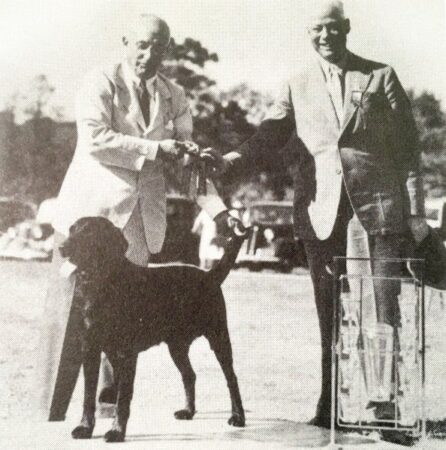
Show champion Raffles of Earlsmoor
Decoy, Shed’s mother, was the second Lab to earn a field trial championship in America. Her full brother, Blind of Arden was the first to earn a field trial championship and also won the first US retriever field stake in 1938.

Field champion Decoy of Arden
His siblings
Some of Shed’s full siblings included:
- CH Earlsmoor Moor of Arden
- CH Earlsmoor Marlin of Arden
- DUAL CH Gorse of Arden
- DUAL CH Braes of Arden
- CH Bass of Arden
Half siblings included:
- FC Gun of Arden
– Grandsire of 2xNFC Spirit Lake Duke and great-grandsire of DUAL CH CFC Ridgewood Playboy and CH Whygin Gentle Julia Of Avec - Marvadel Cinders
– Dam of Can DUAL CH Coastal Charger of Deer Creek and NFC AFC Marvadel Black Gum
His titled offspring include:
CNFC FC AFC Ardyn’s Ace of Merwalfin
FC AFC Bigstone Bandit
CFC Chanbar Jigaboo ***
CH Chukker of Bonniehurst
NFC AFC Creole Sister
FC Dacity Bill
CH Dauntless of Deer Creek
CH Deer Creek Black Ace
FC Firelei’s Hornet
FC CFC Jibodad Gypsy
CFC Nelson’s Black Prince
FC Pickpocket for Deer Creek
CH Snikeb’s Cookie
CH Trixie’s Black Cargo ***
CH Wardwyn Jackpot
Shed’s descendants at Justamere Ranch:
Chip descends multiple times from Shed. Those bloodlines include:
NFC Dual CH CFC Bracken’s Sweep
Dual CH Grangemead Precocious
CFC Chuck of Bracken
FC Dacity Bill
FC Freehaven Muscles
FC Gilmore’s Peggy
FC Shoremeadow Tidewater
FC AFC Tar Baby of Hilly Hill
Dee also descends multiple times from Shed. Those bloodlines include:
Dual CH AFC Alpine Cherokee Rocket
Dual CH Cherokee Buck
Dual CH Grangemead Precocious
Dual CH Ridgewood Playboy
Can Dual CH Coastal Charger of Deer Creek
Can Dual CH Dart of Netley Creek
FC AFC Air Express
FC Beautywood’s Carbon Copy
CNFC FC AFC Belle of Zenith
FC AFC Bigstone Bandit
FC AFC Black Cougar
NAFC FC Bracken’s High Flyer
FC AFC Canis Major’s River Bear
CFC Chanbar Jigaboo QAA
CFC Chuck of Bracken
NFC AFC CFC Cork of Oakwood Lane
FC AFC Cougar’s Rocket
CFC Craigend Rock
CFC Crevamoy Iron Duke
2xNAFC FC Dee’s Dandy Dude
FC Deer Creek’s Bewise
2xNFC CNFC AFC Del-Tone Colvin
NAFC FC Dude’s Double or Nothin’
FC Firelei’s Hornet
FC Freehaven Muscles
FC Gilmore’s Peggy
FC AFC Ginger’s Choc August
FC AFC CFC Grady’s Shady Ladee
NAFC FC CFC Guy’s Bitterroot Lucky
AFC Jilly Girl
FC AFC Les Coup De Grace TD
FC Luka of Casey’s Rocket
FC AFC Meg O’Tar
FC Martens Little Bullet
FC Martens Mister Nifty
FC AFC Mon Tour De Force
FC Mueller’s Stormy Canada
FC Nelgard’s Counter Point
CFC Nelson’s Black Prince
FC AFC Paha-Sapa Chief II
AFC Penny Girl
FC AFC Raider’s Piper Cub
FC AFC Rip’s Bingo
2xNAFC 3x CNFC FC River Oaks Corky
NAFC FC River Oaks Rascal
FC AFC River Oaks Way-Da-Go Rocky
FC Roy’s Rowdy
FC AFC Serrana Sootana of Genesee
Shamrock Acres Windridge Samba CDX
FC AFC Shed’s Prince of Garfield
NFC 2xNAFC Super Chief
FC AFC Tar Baby of Holly Hill
2xCNFC AFC Tar Baby’s Little Sweet Stuff
FC AFC Toni’s Tar
FC AFC CFC Trieven Thunderhead
FC AFC CFC Triple Echo
FC AFC Trumarc’s Raider
AFC Westwinds Shadow of Hope
2x NFC Whygin Cork’s Coot
CNFC FC AFC Yankee Clipper of Reo Raj
FC Zipper Dee Doo
and
CH Dauntless of Deer Creek
CH Rupert Dahomey
CH Whygin Poppitt
CH Woodcroft Daisy,
Conclusion
During his career, Shed earned both US and Canadian Field Championships and a US show championship which qualified him as a DUAL champion. He also ran in five national field championships – winning three times and finishing as a finalist the other two times. At one point his owner turned down an offer to buy him for $10,000 (equivalent of about $150,000 today).
Sometimes the descriptions of field trials from years ago sound more like hunt tests. Don’t be fooled. The tests were real hunting scenarios. On the East Coast, birds were often thrown from a boat well out in the mouth of a bay. An outgoing tide could carry that bird out even farther. Trials were held even if the temperature was below zero, but jumping into frigid water and breaking ice was one of Shed’s specialties. A trial he won as a seven-year-old, included “a 300-yard blind retrieve across the eastern tip of the lake for a shackled duck that was planted several yards from the opposite shore.” 7
He was a good ‘un.
3x National Field Champion, Canadian Field Champion, Dual Champion SHED OF ARDEN
Whelped: March 26, 1939
Owner: Lt. Paul Bakewell III, Deer Creek Kennel
Breeder: W. Averill Harriman, Arden Kennel
Registration: A-330767
Abbreviations:
CH – Show champion
FC – Field trial champion
NFC – National field trial champion
CCW – English Conformation Certificate winner (not a title)
FTW – English Field trial winner (not a title)
CFC – Canadian field champion
Notes:
[1] The National Retriever Field Trial Club, 1941-1960, 62.
[2] “Victory Well Earned”, New York Times December 12, 1942
[3] “Dual Ch. Shed of Arden Wins Retriever Championship”, American Kennel Gazette, January 1943, 65.
[4] Ibid
[5] The National Retriever Field Club, 1941-1960, 79.
[6] “Sport: An Old Dog’s Day”, Time magazine, December 23, 1946
[7] “Shed of Arden Wins Oregon Open All-Age”, American Kennel Gazette, June 1946, 92.

Banchory Bolo was the first-ever Dual Champion Labrador Retriever.
His is an interesting story. Not just rags to riches, but riches to rags and back to riches. Pull up a chair and learn about the dog who still has an influence on Labradors over one hundred years after his birth.
BOLO’S EARLY YEARS
Bolo was two years old when Mrs. Quintin Dick (later Lorna, Countess Howe) entered his life. She had owned his sire, Scandal of Glynn, who was “a charming and beloved companion and a great game-finder.”
When Scandal died, she wanted to find a dog to replace him. Unfortunately, none of the other dogs she owned could fill the gap his passing caused.
Her husband, Quintin Dick, suggested a son by Scandal. However, during the First World War breeding was restricted and Scandal had only sired one litter. In it, there were 13 puppies of which 12 were females.
The only male – originally named Caerhowell Bully – had been given away by his breeder. When Lorna(1) found him, he was given to her with the advice that if she didn’t want to keep him to have him put to sleep. They told her the dog was “hopeless” and had “an evil temper.”
When she picked him up at the train station, she realized what she’d been told was true. The dog was unkempt, had sores on his ears and he growled at her through the heavy muzzle he wore. Although he had a wonderful pedigree, she debated: Should she keep him or put him to sleep as she’d been advised?
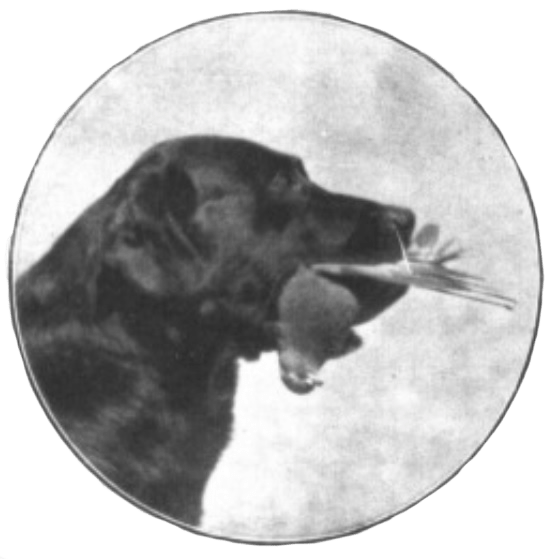
Banchory Bolo
Lorna and Bolo
She must have had a kind heart as she took him home with her. After taking off the muzzle and chain, she turned him loose in a spacious room, but he was distrustful and surly. He wouldn’t come to anyone and it took quite a while to catch him.
Something must have happened to him in his earlier life. Heavy-handed trainer? Malicious kennel help?
He avoided people. When turned out for exercise, he was hard to catch. How could he be trained when he was so distrustful of people? What could soothe the savage beast?
It turns out it wasn’t music, but Lorna’s gentle care. When he became seriously ill, she nursed him back to health. During that time, he realized she was someone he could trust. As he recovered he became devoted to her and was always at her side.
THE STIRRINGS OF GREATNESS
When he started in training, Lorna found he had “a natural love of retrieving, an excellent nose, and a perfect mouth.” However, he also had two failings: he loved chasing rabbits and was terrified of cracking whips. One day when a stable boy happened to crack a whip near him, the fear took over and Bolo blindly sought escape. A tall, spiked gate didn’t stop him from running.
He returned early the next morning, covered in blood. “He had two very deep wounds on his chest, a tear three inches long in his groin and his hind leg and hock torn so badly that the bone was visible.” Because a veterinarian was too far away, Lorna stitched his wounds as he lay still for her.
Her doctoring and subsequent training was well done as the next fall he won a field trial prize. Then he quickly won two field trials and became a field champion. Two years later he also finished his show championship and became the first Dual Champion Labrador.
Lorna said, “He had quite the best nose I have ever seen in a dog and with apparently the greatest ease he would collect runner after runner after several other dogs had failed. I have never had a dog with such great natural ability or one so anxious to please me in every possible way.”
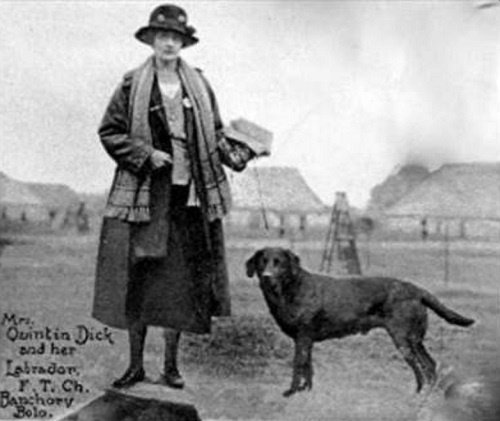
Lorna, Countess Howe and Banchory Bolo
FROM GREATNESS COMES GREATNESS
The genes from several great dogs came together in Banchory Bolo. We have Lord Malmesbury, the Dukes of Buccleuch, and Lord Knutsford (Munden kennels) to thank for their breeding insight and the dogs they produced.
Banchory Bolo’s pedigree:
| Scandal of Glynn | English FTCh Peter of Faskally | Waterdale Gamester |
| Birkhill Juliet | ||
| English FTW Shelagh of Glynn | English FTW Scamp of Glynn | |
| Shelagh of Danesbury | ||
| Caerhowell Nettle | Foxley Kennett | Hirsch’s Ranger |
| Bendysh Bess | ||
| Baker’s Nora | unknown | |
| unknown |
His family
Looking backward in time, Bolo’s sire, Scandal of Glynn, was a son of English FTCh Peter of Faskally. Peter won the International Gundog League’s Championship Stake for retrievers in 1911, but it was his partnership with his handler, Archie Butter, that set him apart from the other retrievers.
Butter realized that if a dog could be guided by his handler, the quicker he would be able to find and retrieve game. To do this, he adapted the methods used by shepherds when handling their dogs using whistles and hand signals. We still use a form of this method today.
Peter of Faskally’s pedigree is filled with dogs from the Munden and Buccleuch kennels. Munden Sixty (born 1897) appears three times in Peter’s pedigree and once more in Scandal of Glynn’s maternal line.
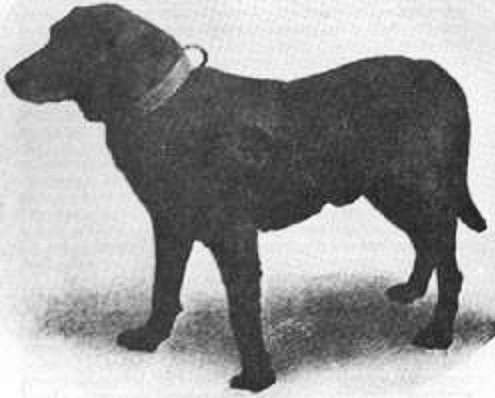
Buccleuch Avon
Sixty’s paternal grandfather, Buccleuch Avon (born 1885), was a gift from the third Earl of Malmesbury to the sixth Duke of Buccleuch.
Avon was sired by Malmesbury Tramp (born 1878) and out of Malmesbury Juno (born 1878). Another male, Buccleuch Ned (born 1882), was also a gift. These dogs were bred to bitches that descended from dogs imported originally by the fifth Duke of Buccleuch.
Another great in Peter of Faskally’s pedigree is Munden Single (born 1899). She was sired by Munden Sixty and descended from Munden, Buccleuch, and Malmesbury dogs. She’s best known for being the first Labrador to win a Challenge Certificate and the first Labrador to run in a field trial.
More Munden, Buccleuch, and Malmesbury
Less is known about Scandal of Glynn’s maternal side. His maternal grandfather, Scamp of Glynn FTW, traces to Buccleuch Ned, the other male gifted by Lord Malmesbury. And his maternal grandmother, Shelagh of Danesbury, is mostly from Munden dogs that trace back to the Buccleuch and Malmesbury kennels.
Even less is known about Banchory Bolo’s mother, Caerhowell Nettle, although her father traces back to Peter of Faskally as well.
BOLO’S LEGACY
With all the good genes passed down from his ancestors, it’s not surprising that he also produced well. He sired both show champions and field trial champions.
Bolo’s show offspring
In 1921, he was bred to Brocklehirst Nell (owned by Mrs. Dinwoodie) and sired English Ch Banchory Bluff, English FTCh Nith of Halleaths, and Brocklehirst Daisy FTW. Bluff was the maternal grandsire of English FTCh Balmuto Hewildo. Bluff was owned by Lorna.
Also in 1921, he was bred to Murrayfield Bett (owned by Mr. Dinwoodie) and sired English Ch Brocklehirst Donner. This dog was also owned by Lorna.
Yet another litter in 1921, produced English Ch Beningbrough Tangle. He finished his show championship, including winning the CC at Crufts in 1930 and he also won a field trial. So close to being another Dual Champion! He was bred by The Earl of Chesterfield and owned by Lorna. His mother was Thyme, a daughter of English Ch Ilderton Ben.
In 1922, Bolo was bred to a granddaughter of English Ch Ilderton Ben. Her name was Malta of Lunn and was owned by the Earl of Clarendon. In this litter was a female named English Ch Banchory Kelpie, owned by Lorna.
Breeding dogs all but stopped during World War I. This sent the Munden kennel to the edge of extinction. However Lorna “gave Lord Knutsford a puppy on the condition that he should eventually breed her with Dual Champion Banchory Bolo.”
He registered this puppy as Munden Scarcity. Her sire was English Ch Banchory Lucky and her dam was Banchory Betty. In Scarcity’s litter by Bolo, she produced both English Ch Banchory Danilo FTW and English Ch Munden Solo FTW. Lord Knutsford also kept Singer, a bitch, and another bitch was given to His Majesty the King.
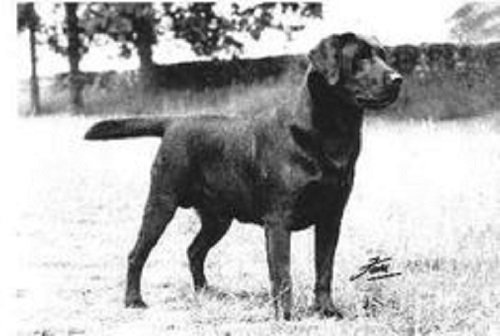
Banchory Danilo
One of Bolo’s best sons
Danilo won 33 Challenge Certificates in the show ring and won the best exhibit in the Kennel Club Show in 1925. He went on to also win two field trial honors in 1924, handled by Lorna. Danilo sired English Ch Drinkstone Pons of Wingan (sire of American Ch Echo of Arden), English Ch Drinkstone Dan, and Haylers Danilo (sire of English Ch Poppleton Black Lancer).
When Danilo’s grandson, Hiwood Risk, was bred to Peggy of Shipton we see some of the Arden dogs, including American National Field Champion Tar of Arden and her offspring – American FC Firelei of Deer Creek, American NFC Black Magic of Audlon, American Dual Ch CFC Little Pierre of Deer Creek.
Danilo’s brother, Munden Solo, also did well at shows. At Crufts in 1927, he competed in ten classes, won six, and placed in three more. The judge wrote of him, ‘If there had been a little more of him in size, I think he would have been very near perfection.’
Bolo sired another English show champion, Banchory Bolo’s Trust, in 1926. His mother was Beaulieu Nance (daughter of English DUAL Ch Banchory Sunspeck).
English DUAL Ch Bramshaw Bob, double-bred on Bolo, won Best in Show at Crufts twice – 1932 and 1933. Lorna bought him from Sir George Thursby and when she took him to Crufts in 1932, Bob won all the classes he was entered in and won Best in Show on the second day.
Lorna said, “Cruft’s Show was, and still is, a great meeting place for gamekeepers. I shall never forget the overwhelming reception they gave Bob when the award was announced; it was so kind of them. They were pleased that a working gundog should receive this much-coveted award.”
Bolo’s field offspring
Bolo was bred to Kirkmahoe Dinah FTW in 1921. This litter included English National FTCh Kirkmahoe Rover, Banchory Corbie FTW, and Choice Of Kirkmahoe FTW.
Banchory Corbie won one Challenge Certificate (show points) and won the 1923 International Gundog League (IGL) Nomination Stake. Then he “broke his shoulder by galloping into a guard post” thus ending his show and field trial career. Lorna described him, “Corbie was in character and temperament all that a Labrador should be. He was highly intelligent, very faithful, a wonderful watch-dog and guard, yet very gentle with children. He had the great game-finding ability which goes with good nose and the brains to use it.”
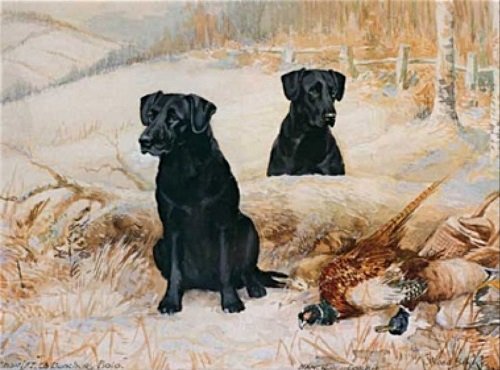
Banchory Bolo and his son, Banchory Corbie
Another Bolo son was born in 1923, Banchory Roger FTW. He was linebred on English National Ch Peter of Faskally and on Munden Sentry.
Another male, English FTCh Balmuto Hewildo, was also double-bred on Bolo. Instead of winning in the show ring, he won the IGL Retriever Championship in 1936. This is comparable to the National Retriever Championship in the US.
In short, Bolo was a great producer.
A LEGEND
Author C. Mackay Sanderson wrote, “Bolo’s coming may be said to have breathed a spirit of new life into the breed, the prestige enjoyed by this dog as a competitive and stud force giving lasting impetus to Labrador fortunes and subsequently his name runs like a golden thread through all the vital streams of progress.”
“The Field wrote of Bolo: ‘If ever evidence were needed of the character of a great dog, and of his influence on the generations following him, it was to be found at the Retriever Championship Trial held at Idsworth last week [December 1932]. Out of fourteen dogs that won prizes, eight were descended from Banchory Bolo.'”
But Bolo also had another legacy – he tended to throw white hairs on the feet. These ‘Bolo marks’ or ‘Bolo pads’ are still sometimes seen on the bottom of the front feet and/or the back of the front pasterns.
Bolo died in July 1927. It was ten years before Lorna was able to give her heart to another dog.
English Dual Champion Banchory Bolo
Whelped: December 29, 1915
Died: July 10, 1927
Owner: Lorna, Countess Howe (AKA Mrs. Quintin Dick)
Breeder: Sir John S Harmood-Banner
Original name: Caerhowell Bully
Registration: KC SB 218AA
1. Although she became Lorna, Countess Howe because of her second marriage, she was known as Mrs Quintin Dick during Bolo’s lifetime. However for the sake of ease, I’ve used her first name here as it’s how she’s known by Lab enthusiasts worldwide.
Abbreviations:
Ch – Show champion
CC – Challenge Certificate (show points)
FCh – Field trial champion
NFCh – National field trial champion
FTW – Field trial winner (not a title)
CFC – Canadian field champion
IGL – International Gundog League
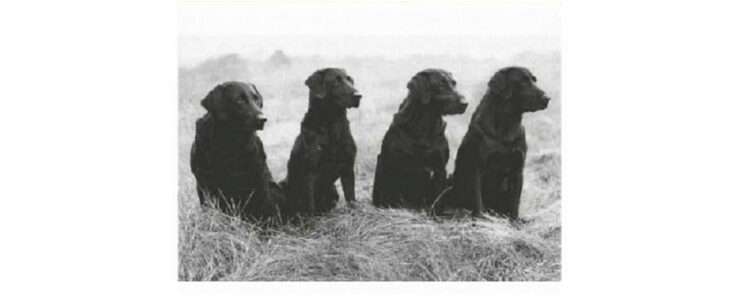
Not only one of 37 Labradors in the US to earn both a show and a field championship, but part of a dynasty. Four Dual Champions in four consecutive generations – 3xNFC CFC Dual CH Shed of Arden, father of Dual CH Grangemead Precocious, grandfather of Dual CH Cherokee Buck and great grandfather of Dual CH AFC Alpine Cherokee Rocket.
HIS BACKGROUND
Precocious was bred and owned by Thomas W. Merritt, a man who spent many years supporting the breed and competition he loved.
- Judged over 50 field trials, including the first National Amateur Stake in 1957 and the National Open (4 times).
- One of the original incorporators of the National Club.
- Past President of the Labrador Club.
- Was a Director of the American Kennel Club.
- President and Editor-in-Chief of the Retriever Field Trial News.
That’s in addition to breeding and owning some of the top Labs of the 1940s and 1950s. He reminds me of Lorna, Countess Howe in their efforts for the breed plus the great dogs they each owned.
Merritt mentioned one of his first puppies was Grangemead Angel who was sired by FC Freehaven Jay. Her mother was a granddaughter of Eng CH Banchory Trueman – another link to Lorna. He bred Angel to Am FC Eng FTCh Hiwood Mike who was a grandson of Eng Dual CH Banchory Painter, yet another link.
Grangemead Sharon, mother of Dual CH Cherokee Buck, was a puppy from the Angel x Mike litter.
HIS PEDIGREE
| 3xNFC CFC Dual CH Shed of Arden | CH Raffles of Earlsmoor | Thatch of Whitmore (Eng CCW) |
| Task of Whitmore (Eng CCW) | ||
| FC Decoy of Arden | Odds On (Eng FTW) | |
| Peggy of Shipton (Eng FTW) | ||
| Huron’s Lady | Am Eng CH Banchory Trump of Wingan | Blenheim Scamp (Eng FTW) |
| Lady Daphne | ||
| CH Bancstone Lorna of Wingan | Eng Dual CH Bramshaw Bob | |
| Eng CH Drinkstone Peg |
The Labrador Retriever was still pretty new to our shores at this time and all eight of Precocious’ great grandparents were British. Shed of Arden was sired by a British import and his maternal grandparents were both British imports. Precocious’ maternal grandparents were also British imports.
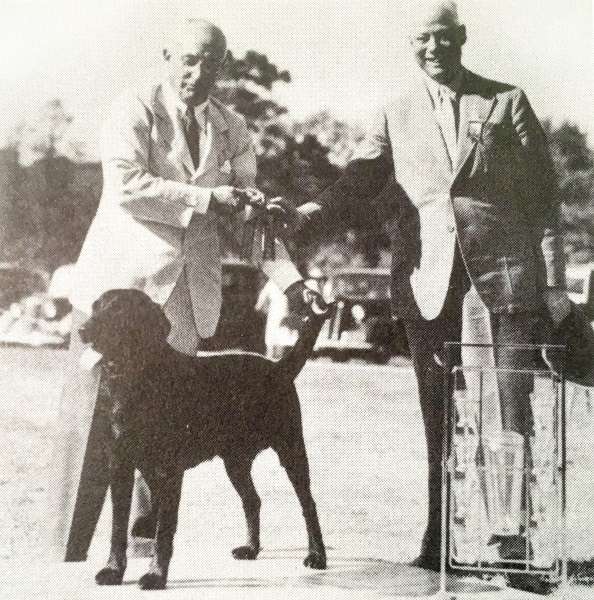
CH Raffles of Earlsmoor

3xNFC CFC Dual CH Shed of Arden

FC Decoy of Arden (right)

Banchory Trump of Wingan
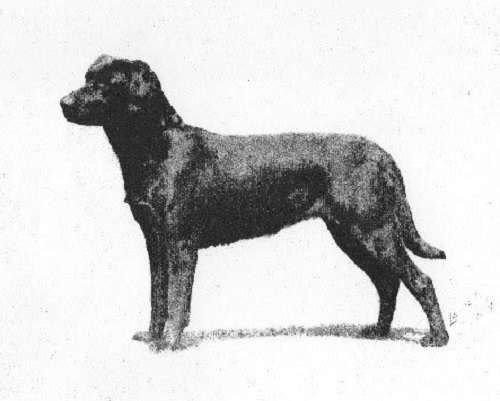
Bancstone Lorna of Wingan
PRECOCIOUS GETS HIS START
He was born June 21, 1946, along with at least two litter brothers, Jock of Athabaska and Deer Creek Black Ace. Both brothers finished their show championships.
Merritt remembers Precocious as “a bigger dog than Shed. He was a good marking dog, especially in water and especially strong in water triples.” According to Helen Warwick in The Complete Labrador Retriever.
He was trained and handled by Harold Berentsen. He won his first Open stake at 28 months and finished his field championship about a year later.
During the summer of 1950 he became a show dog and often won Best of Breed. He even placed in the Group a couple of times. Admittedly entries were much smaller than they are today. He won his first Best of Breed on May 7, 1950 and finished his show championship on June 18, 1950. Having already finished his field championship, he became a Dual Champion that same day.
He qualified for and ran in four National Championships – 1948, 1949, 1950 and 1951. He was a finalist in 1950 and 1951.
HIS LEGACY
Some people say he was named Precocious because he sired his first litter at the age of six or seven months. Based on birth dates, he was actually a grand old pup of nine months when he did the deed.
But what a deed! In that one litter with Grangemead Sharon he sired:
DUAL CH CHEROKEE BUCK
– sire of Dual CH AFC Alpine Cherokee Buck
— grandsire of NAFC FC Andy’s Partner Pete
– sire of Ironwood Cherokee Chica
— grandsire of NFC 2xNAFC Super Chief (Hall of Fame), FC AFC Carr-Lab Penrod, FC Chief Black Feather, FC AFC Paha Sapa Warpaint, FC AFC Paha’s Pow-Wow, Spring Farms Lucky QAA
– sire of Luscious Licorice Lass
— grandsire of FC AFC CFC Triple Echo
FC CHEROKEE MEDICINE MAN
FC FREEHAVEN MUSCLES
– sire of FC AFC Paha Sapa Chief II (Hall of Fame)
— grandsire of NFC 2xNAFC Super Chief (Hall of Fame), FC AFC Carr-Lab Penrod, FC Chief Black Feather, FC AFC Paha Sapa Warpaint, FC AFC Paha’s Pow-Wow, Spring Farms Lucky QAA
— grandsire of NAFC FC Rebel Chief of Heber (Hall of Fame) and AFC Jilly Girl
– sire of FC Nelgard’s Counter Point
— grandsire of Dual CH CFC Ridgewood’s Playboy and FC AFC Sand Gold Kim
You can see these boys in the header image – left to right – Grangemead Precocious, Freehaven Muscles, Cherokee Medicine Man and Cherokee Buck.
Unfortunately Grangemead Sharon was given away before her sons were able to prove themselves. Who knows if a second litter of Precocious x Sharon would have equaled or bested the first litter.
Other offspring:
– sire of CFC Highlander’s Buccaneer and CAN CH Highlander’s Diana
— grandsire of Can Dual CH Blyth’s Knave of Spades
– sire of Beautywood’s Creole Jane
— grandsire of Don’s Ginny Soo
— great grandsire of 2xNAFC 3xCNFC FC River Oaks Corky (Hall of Fame)
— grandsire of FC Roy’s Rowdy
And, yes, we have a bit of Precocious in our dogs. Our pretty Dee and all her offspring, including Arwen, Tory and Cotti, trace back to Precocious several times.
1 – Through 2xNAFC FC River Oaks Rascal to Beautywood’s Creole Jane to Precocious
2 – Through 2xNAFC FC River Oaks Rascal to Dual CH AFC Alpine Cherokee Rocket to Precocious
3 – Through Shamrock Acres Juego De Azar to FC Freehaven Muscles AND Dual CH Cherokee Buck to Precocious
4 – FC AFC Raider’s Piper Cub to FC AFC Paha Sapa Chief II to Precocious
5 – Timberlane Cinnamon to 2xNAFC 3xCNFC FC River Oaks Corky to Precocious
6 – Timberlane Cinnamon to Black Beauty of Random Lake to FC Freehaven Muscles to Precocious
7 – Timberland Cinnamon to Muscle Man of Random Lake to Rise and Shine at Duckwind to Precocious
8 – Timberland Cinnamon to Cherokee King Bojo to Precocious
9 – Timberland Cinnamon to Luscious Licorice Lass to Precocious
10 – FC AFC CFC Trieven Thunderhead to FC AFC Paha Sapa Chief II to Precocious
11 – FC AFC CFC Trieven Thunderhead to Ironwood Cherokee Chica to Precocious
12 – FC AFC CFC Trieven Thunderhead to AFC Jilly Girl to Precocious
13 – Dale’s Double Hope to Dual CH CFC Ridgewood Playboy to Precocious
14 – Dale’s Double Hope to FC AFC Serrana Sootana of Genesee to Precocious
15 – Dale’s Double Hope to FC AFC Toni’s Tar to Precocious
16 – Dale’s Double Hope to Ebony Sally of Widgeon Bay to Precocious
17 – Hard Driving Abigail to Cherokee King Bojo to Precocious (twice)
18 – Hard Driving Abigail to Luscious Licorice Lass to Precocious
And Chip too goes back to Precocious. Through Jilly Girl (twice), Beautywood’s Creole Jane (9x), Super Chief (twice), Gunfield’s Super Charger, Paha Sapa Chief II (separate from Super Chief) and Howmor’s Dark Gypsy.
DUAL CH Grangemeade Precocious
Whelped: June 21, 1946
Breeder: Thomas W. Merritt
Registration: S-127563

These are mostly American titles (AKC and UKC/HRC), but there are also some we see from Canada and England.
In the pedigrees I share I try to differentiate between titles earned in the US versus other countries.
For example, CH = AKC show champion, U-CH = UKC show champion, Can CH = Canadian show champion, Mex CH = Mexican show champion, Eng CH = English full show champion, and English Sh CH = English show champion.
Also included are some that are not technically titles because they’re not bestowed by the country’s governing body.
For example, WC and CC are certificates given by The Labrador Retriever Club rather than by AKC.
There are many organizations awarding titles, but these are the main titles we see for the retriever breeds.
FIELD TITLES |
|
|---|---|
| DC or DUAL CH | A Show Champion AND Field Champion – Note: We haven’t had one of these in Labradors since the early 1980s |
| FC | Field Champion |
| AFC | Amateur Field Champion |
| “C” in front of FC or AFC | Canadian Field Champion – sometimes seen as FTCH |
| “N” in front of FC, AFC, CFC OR CAFC | National Field Champion titles |
| Eng FTW | English Field Trial Winner (part of the Eng FTCH, but not actually a title) |
| QAA | Qualified All-Age – means the dog has won enough in the Qualifying stake to compete in the Open or Amateur stakes at field trials, not actually a title (sometimes seen as *** following the name) |
| QA2 | Qualified All-Age 2, recent AKC title for dogs that have twice met the requirements to compete in the Open or Amateur stakes at field trials |
| JH | Junior Hunter |
| SH | Senior Hunter |
| MH | Master Hunter |
| MNH | Master National Hunter – listed as MNH4 or MNH5, etc when the dog has passed the Master National more than 3 times |
| SHR | Started Hunting Retriever (HRC/UKC title) |
| HR | Hunting Retriever (HRC/UKC title) |
| HRCH | Hunting Retriever Champion (HRC/UKC title) |
| GRHRCH | Grand Hunting Retriever Champion (HRC/UKC title) |
| UH | Upland Hunter (HRC/UKC title) |
| CPR | Certified Pointing Retriever (APLA title) |
| APR | Advanced Pointing Retriever (APLA title) |
| MPR | Master Pointing Retriever (APLA title) |
| GMPR | Grand Master Pointing Retriever (APLA title) |
| WC | Working Certificate (LRC certificate) |
| WCX | Working Certificate Excellent (sometimes awarded by local breed clubs) |
SHOW TITLES |
|
|---|---|
| DC or DUAL CH | A Show Champion AND Field Champion – Note: We haven’t had one of these in Labradors since the early 1980s |
| CH | Conformation Show Champion |
| Pointed or Major pointed | The dog has won in the show ring, but is not yet a champion – not actually a title |
| GCH | Grand Champion – also GCHB Bronze, GCHS Silver, GCHG Gold, GCHP Platinum |
| U-CH | UKC Conformation Show Champion |
| U-GRCH | UKC Conformation Show Grand Champion |
| Eng CH | English Show Champion w/field qualification certificate or Eng Sh CH if the dog qualified in the show ring, but has not qualified in the field (approximately WC equivalent) |
| Eng CCW | English Challenge Certificate Winner (part of the Eng CH, but not actually a title) |
| BIS | Best in Show (achievement, not a title) |
| BISS | Best in Specialty Show (achievement, not a title) |
| BPIS | Best Puppy in Show (achievement, not a title) |
OBEDIENCE TITLES |
|
|---|---|
| CGC | Canine Good Citizen |
| CGCA | Advanced Canine Good Citizen |
| BN | Beginner Novice |
| CD | Companion Dog |
| GN | Graduate Novice | CDX | Companion Dog Excellent |
| GO | Graduate Open |
| UD | Utility Dog |
| UDX | Utility Dog Excellent |
| OM | Obedience Master |
| OGM | Obedience Grand Master |
| OTCH | Obedience Trial Champion |
| NOC | National Obedience Champion |
RALLY TITLES |
|
|---|---|
| RN | Rally Novice |
| RI | Rally Intermediate |
| RA | Rally Advanced |
| RE | Rally Excellent |
| RM | Rally Master |
| RAE | Rally Advanced Excellent |
| RACH | Rally Champion |
| RNC | Rally National Champion |
TRACKING TITLES |
|
|---|---|
| TD | Tracking Dog |
| TDU | Tracking Dog Urban |
| TDX | Tracking Dog Excellent |
| VST | Variable Surface Tracking |
| CT | Champion Tracker |
AGILITY TITLES |
|
|---|---|
| ACT1 | Agility Course Test – Introduction to Agility |
| ACT2 | Agility Course Test – in between Introduction and Novice levels |
| NA | Novice Agility |
| NAP | Novice Agility Preferred |
| NAJ | Novice Agility Jumper |
| NJP | Novice Agility Jumper Preferred |
| OA | Open Agility |
| OAP | Open Agility Preferred |
| OAJ | Open Agility Jumper |
| OJP | Open Agility Jumper Preferred |
| AX | Agility Excellent |
| AXP | Agility Excellent Preferred |
| AXJ | Excellent Agility Jumper |
| AJP | Excellent Agility Jumper Preferred |
| MX | Master Agility Excellent |
| MXP | Master Agility Excellent Preferred |
| MXJ | Master Excellent Jumper |
| MXP | Master Agility Jumper Preferred |
| MACH | Master Agility Champion |
| PACH | Preferred Agility Champion |
| AGCH | Agility Grand Champion |
| NAC | National Agility Champion |
| U-AGI | Agility I (UKC title) |
| U-AGII | Agility II (UKC title) |
| U-ACH | Agility Champion (UKC title) |
| U-ACHX | Agility Champion Excellent (UKC title) |
VERSATILE COMPANION TITLES |
|
|---|---|
| VCD | Versatile Companion Dog |
| VCCH | Versatile Companion Dog Champion |
TRICK DOG TITLES |
|
|---|---|
| TKN | Trick Dog Novice |
| TKI | Trick Dog Intermediate |
| TKA | Trick Dog Advanced |
| TNP | Trick Dog Performer |
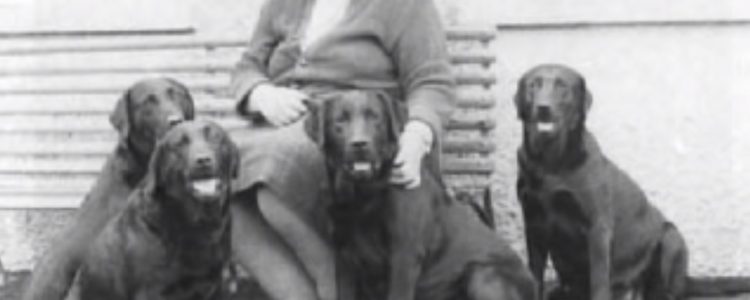
Mary Roslin Williams of Mansergh Gundogs
She bred Labs, she hunted over Labs, she competed with Labs and she taught about Labs. She had 7 generations of champions, and 15 or so dogs who won field trial awards.
In the early days, she lived in Mansergh Parish, just south of the Lake District, in England.
Mary Roslin Williams taught from practical experience and common sense.
Although she’s no longer with us, she left behind knowledge that she shared. Take a half hour to listen.
“It was with great sadness to me, that when they named the Labrador they didn’t call it the ‘Labrador Water Retriever’ … because we forget that the dog is a water dog. It’s job was water work.
“It’s job still is water work and we’ve adopted it and adapted it for different works… We ought to remember that, both when we breed and when we judge….
“Now here is a difficult thing because this is type and however much you have a standard, one thing it cannot describe is type. You’ve got to have type in your head. …
“My criteria for Labrador type is a very simple one. It must look like a Labrador. …
“… a Labrador’s job is not to hunt in front of you, flushing rabbits, flushing pheasants, however good.
“It is not to be a guide dog for the blind.
“It is not to be a dog for finding drugs or any of these useful things [like] finding … a dead body… That’s not it’s job.
“It’s very nice of it to do it… but it is not it’s job.
“It’s job is to sit or walk at heel until told to go. And it’s only told to go either at the end of the drive or when the bird comes down if you’re in … a duck blind and you want it to go.
“It shouldn’t run in, you should say “Right, I see that goose is going to escape. Right, go.”
“But it’s very easy to sit here and say it and very difficult to do, but that is it’s job.
“Then when the bird is down, the dog is supposed to go out and to get the scent – not 300 yards away like a Pointer, not groveling like a Spaniel with it’s elbows out – it’s supposed to get the best high scent from a reasonable distance and then be able to put it’s head down, follow the scent without difficulty … and then it picks it’s bird up. And it may have a very heavy thing to pick. And it’s supposed to have the lift and the shoulders to take it.
“And for that you need a dog bred on exactly classical lines. And a classical line is a level back, not a rake. A level back. Any retrieving dog that has to also mark should have a level back. …
“It should have a longer back to its neck than to it’s throatline. … It should have an 11″ back to its neck and a 4″ throatline, not an 11″ throatline and 4” back.
“If it was a horse it would be putting it’s ear in your mouth…
“It’s very dangerous for a Labrador to have that enormous exposed windpipe… And then when they pick their bird, it stands to reason that… the long line is on the top and the short line is underneath.
“Now the shoulders should be laid back and this is very important too.
“In a pointing setter, they have a laid back shoulder. Fair enough. But they don’t have the classical right angle at the point of the shoulder. They are over angulated… We want the right angle or thereabouts give or take a few degrees.
“If you have a laid back shoulder, a right angle there and a level back … the foreleg comes back under the girth. It’s not under their ear and neither is it straight under the point of the shoulder. It is back and the elbow is under the girth.
“So there you have the exact angulation that the dog can easily mark the bird when he’s walking because it’s easy for him to have his head up. He can get a scent within a reasonable distance… and then put his head down. And he can get his head down perfectly easily without having to put his elbow out like a Foxhound does. So therefore you have a perfect mechanism there.
“And he must have that long line on the top of his neck to pick his bird. He then picks his bird – which takes a lot of strength – and gets it back onto the layback of his shoulders easily carrying it on the layback of his shoulders.
“So if you have the classical front, that is exactly right for a Labrador, a Golden, a Flatcoat, a Curly, a Ches, but it isn’t right for a Pointer and Setter. And it isn’t right for a Foxhound. They have their own fronts, slightly open.
“Now we come to the Spaniels. The Spaniels job is to grovel about on the ground.
“He has to quest with his nose down and so therefore he is over angulated. His shoulder is slight constantined so that he has less than a right angle at the point of the shoulder and he has a more open angle at the elbow. And that is so he can grovel and get down and shovel about.
“And he has to pick up a thing that is very, very much heavier in proportion to his weight, particular a Cocker… and they do it because they can get their heads underneath.
“They don’t pick them up like a show Cocker does and this is why the show Cocker is very useless for work. They are over their legs and they are not angulated properly for a working Cocker.
“They more or less got a Labrador’s angulation. And when they try to put their heads down they’re trying to lift a very heavy weight … and they can’t do it. It’s too heavy for them.
“And so with that working angulation … they come under their bird… and before you can say Jack Robinson, the hare is across their shoulders and they’ve got the weight back on their shoulder blade.
“So the angulation is the most important thing and if anybody says to you a shoulder is just one of those things, it isn’t. It is absolutely important in a working dog… You must breed your shoulder to suit your work. …
“Being able to get down as easily as up and being able to up as easily as down, you need to have a level back.
“And if you have a level back, it very nearly stands to reason that your angulation will be right behind. And if your angulation isn’t right behind, then you can be jolly sure the shoulder is wrong.
“… if you have an over angulated shoulder with open angles, like a Pointer – I’m citing one of my own dogs now.
“I had a lovely dog name Tarmac … and a very good worker. But I can cite him because he was wrongly made.
“He had a marvelously erect shoulder. He then had a raked back. And the consequence was that he was over angulated behind so that he had too much stifle and too much hock – too long a hock – and it was too far behind him. And that is what happens when you get a raked back.
“Now that was the most rightful inconvenience to him when he was swimming because he swam like a Pointer.
“He was all right once he got the bird in his mouth, but when he didn’t have a bird in his mouth the fact that he didn’t have a level back and that he had an over angulated hind legs because of the fact that the rake pressed them down, he had difficulty in the water work. So I know from experience that is not a good thing. …
“At one time because we had a craze for very, very short backs – which they were mistaken for short coupling because a short back is not short coupled, the word ‘short-coupled’ means the loin – and because they thought they must have very short backs, they were absolutely cramming dogs so close together that they had no where to put their feet when they ran because they were crabbing and they had a very short line … from the point of the hip to the point of the buttock, they had no rumps whatsoever.
“And I am quite certain for work – particularly swimming – you must have a decent balanced length from the point of the hip to the point of the buttock. …
“Now if you’ve got your backline right, then you’re going to have your angulation just about right.
“And it’s well to remember – again – that a Labrador is not meant to stand with it’s legs out behind it like a Pointer or a Setter. They’re meant to stand more or less under the point of the buttock.
“In other words the dog is standing slightly over his leg and he mustn’t stand sickle-hocked with his feet too far forward.
“He mustn’t stand like a Pointer or Setter with … a rakish backline which means he’s over angulated.
“And a very important point, … for a perfectly balanced dog … from the hock to the ground … should be at exact right angles to the ground – not stretched out back, nor sickle underneath. …
“If that dog drops it’s hock correctly, then it is standing absolutely correct on it’s feet and you’re less likely to have foot trouble.
“… If you’ve got your angulation right and your level back, you’ve got a balanced dog standing on it’s feet correctly with it’s weight very, very slightly on it’s hocks … and it should stand in a position … that it could jump in any direction immediately. It can either jump forward or backwards or to either side because it’s slightly on it’s hocks.
“Any horseman will know that you must not turn a horse on its forehand… if they stand just in that balanced position, so that they could take off in any direction, you’re much less likely to have joint trouble in later life and you won’t have foot trouble. You won’t have toe trouble.
“Those, to me, are the salient points of a Labrador’s conformation.
“You must have the coat. You must be coated right over, even the testicles and inside of the thighs … with the same coat all over. And it must be dense.
“You want the nice balanced dog with a correct backline, very particularly the correct shoulder and then you will get the correct hindquarters.
“Standing correctly on it’s feet. And then you get a Labrador which can do absolutely any job. …
“And besides that, …it has to have a tender mouth and the ability to retrieve, the ability to mark and a thousand other things that you have in field trials and it’s like trying to get your football pools right. You’ll never do it, but we try.”
Would you like to learn more? She wrote two books – and although they can be hard to find – they are worth the effort.
Advanced Labrador Breeding (aka Reaching for the Stars)
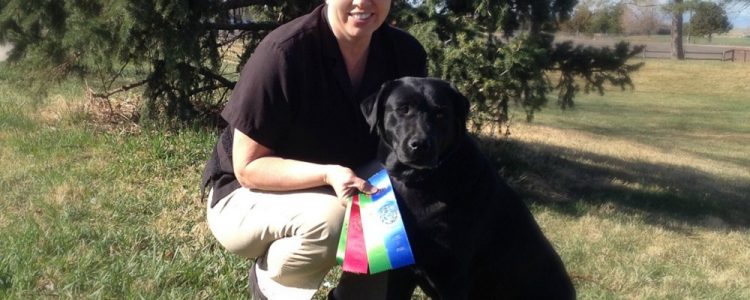
We had a great weekend! Jazzy finished her CD obedience title with a second place on Saturday and a first place on Sunday.
Jazzy had great scores and on Sunday it was even good enough to have us in the lead for High in Trial for a couple of hours – until a dog in Utility B turned in a blazing performance and knocked us out by a few points. Oh well! She did enjoy her special hamburger!
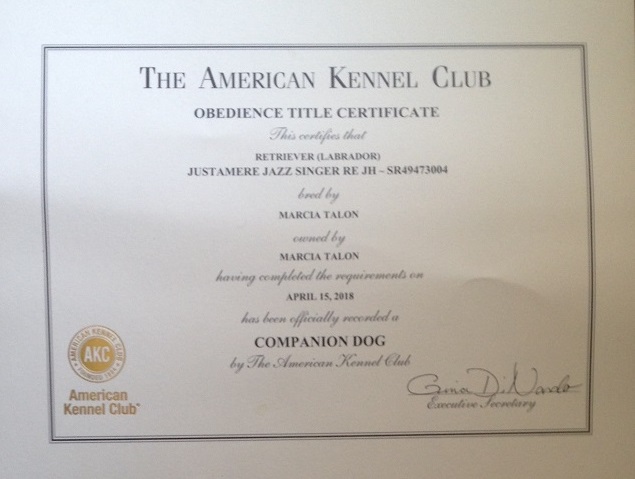
The CD, or ‘Companion Dog’, obedience title involves a lot of walking with the dog at heel, both on and off-leash. There is also a recall where the dog has to stay sitting as the handler walks across the ring and calls the dog and a stand for examination where the dog must stand still, off-leash, and not move while the judge touches the dog. And finally the long sit and long down exercises where all the dogs line up along one side of the ring and must stay put as the handler walks across the ring. This is done off-leash, first sitting for one minute and then staying down for three minutes.
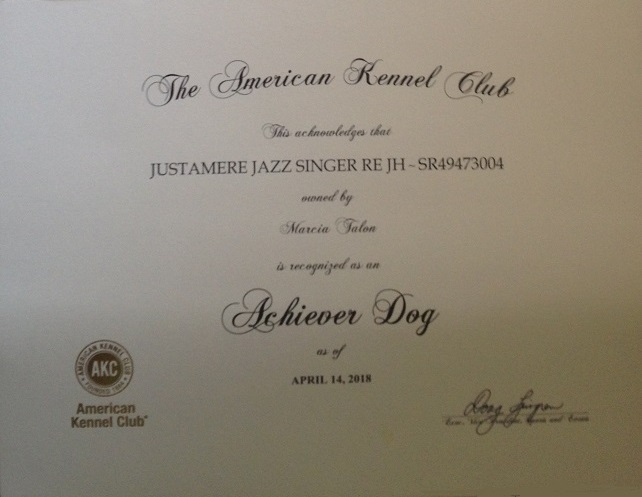
According to AKC, “The Achiever Dog certificate program is designed to recognize those exhibitors and dogs who participate in multiple sports. A dog will receive an AKC Achiever Dog certificate when they have been awarded a placement or earned a qualifying score in three different sports.”
Jazzy earned titles in obedience, Rally and hunt tests.
(Updated Apr 4, 2020) English Labs, American, field-type, show dog – how can there be so many different styles of dogs and all be considered Labradors? My guess is that the breed is just too popular – for 28 years now (since 1991) Labs have been the #1 breed in America per the American Kennel Club (AKC). Distinctive styles have evolved to suit everyone’s varying tastes, and I’m not saying that’s a good thing, it just is.
At one end of the continuum are the show dogs – often called “English Labs.” They tend to have heavy bodies, blocky heads and short legs. I think they’re a product of the more is better syndrome – the standard calls for a broad head, so let’s make it massive, etc. They’re also a product of what wins – a dog wins Best of Breed at a prestigious show and people sign up in droves to breed to him in hopes of duplicating him and his wins. Unfortunately some of these dogs have become caricatures of the original Labs who were bred to be field dogs. A 100-pound, 22″ dog with profuse coat wouldn’t be my first choice to chase wild ringnecks in South Dakota. That said, I am seeing a shift to a more moderate dog in the show ring, except for the Labrador-only specialty shows where structure is generally excellent, but more-is-better still reigns.
At the other end are the field dogs – often called “American Labs.” They tend to be tall and slender with whip-like tails, skinny heads and lots of energy. These dogs can spend all day hunting or running multiple marks at tremendous distances and still want more. They too are products of the more is better and the whatever-wins syndromes. These dogs are generally bred for their abilities rather than their looks – trainability, marking ability, and intelligence. These breedings are all about trying to produce field trial winners with less regard for the dog’s structure or appearance. However there are some field-bred dogs who still look like a classic Labrador – dogs from early in the breed’s history up until the breed really started to diverge in the 1960s.
I’ve seen an adult female Lab who had the height, bone structure and even head shape of a Whippet. I’ve also seen an adult male Lab who had heavy bone, massive head, thick coat and, except for the height difference, could have been mistaken for a Newfoundland. Some also have a short muzzle and very deep stop (where the tops of the skull and muzzle meet) that reminds me of a Neanderthal. No joke!
To be fair, dogs from both ends of the continuum fill particular needs and are loved and cherished by their owners. Plus there are many dogs that fall somewhere between the two extremes. However the extremes are quite different from the classic Lab – a medium sized dog who loved to retrieve.
I imagine owners of both styles are asked, “What breed of dog is that?” If that’s the case then those dogs are not “typy.” Type equals that which makes a Lab distinguishable from a Golden Retriever or a Rottweiler or a German Shepherd or any other breed. According to the Labrador standard, the “most distinguishing characteristics of the Labrador Retriever are its short, dense, weather resistant coat; an ‘otter’ tail; a clean-cut head with broad back skull and moderate stop; powerful jaws; and its ‘kind’ friendly eyes, expressing character, intelligence and good temperament.”
Here are a couple of classic Labs:
First, is Dual CH-NFC-AFC-Can CH Shed of Arden, (the black dog) a great Lab of the past. He not only earned a show championship in two countries, but was also a three-time National Field Champion! Shed was not so tall and lanky as many of the field dogs of today, nor was he so blocky as most of the current show dogs.

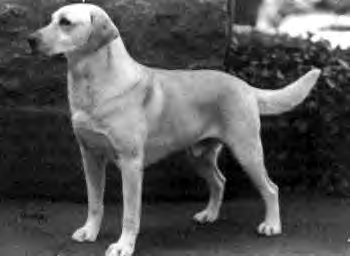
Another great from the past was CH Shamrock Acres Light Brigade. “Briggs was an outstanding show dog and sire. He produced 93 AKC Champions and won 12 Best in Show awards and 75 Sporting Group placements.” Compared to show dogs today he had way more leg and less substance, but look at those shoulders and the balance! I’d bet he moved exceptionally well.
By the way, most of my dogs have both of these famous boys in their pedigree!
I am happy to see some progress – or at least interest – in returning to the moderate Lab, one not overdone or underdone in body style and that still has the desire to retrieve. We call these dogs Dual-Purpose Labradors.
A well-respected, long-time show breeder told me recently that the dog can be pretty, but MUST have the desire to retrieve to be a true Lab.
